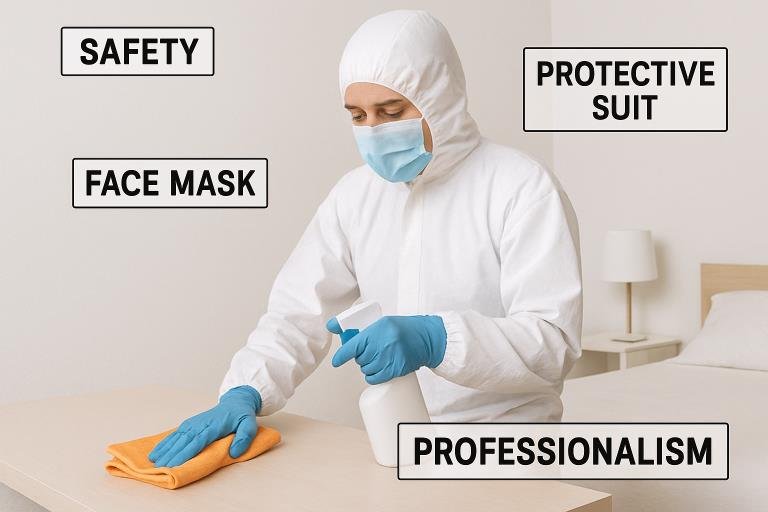Key Takeaways
- Trauma clean-up is crucial after incidents involving biohazardous materials to ensure safety and restore the environment.
- Strict safety measures, regulatory compliance, and emotional sensitivity are essential at every step.
- Professional help is critical for effective, lawful, and respectful remediation.
Introduction to Trauma Clean-Up
Trauma clean-up is essential to events like accidents, crimes, or unattended deaths. The process goes beyond surface cleaning to ensure the complete removal of hazardous biological materials. Proper trauma clean-up is critical for restoring the physical environment and protecting the health and well-being of all who may re-enter the affected area.
The sensitive nature of trauma scenes calls for professional expertise and specialized tools. Failing to address contaminants thoroughly can result in ongoing risks, including exposure to bloodborne pathogens and infectious materials. Thorough decontamination safeguards health and helps families and communities move forward after tragic events.
Discretion and empathy are vital in these emotionally charged situations. Experienced professionals approach each scene with sensitivity, respecting both the technical requirements and the emotional needs of those impacted. They help reduce the trauma associated with such events by handling the details efficiently and compassionately.
The sensitive nature of trauma scenes calls for professional expertise and specialized tools. Failing to address contaminants thoroughly can result in ongoing risks, including exposure to bloodborne pathogens and infectious materials. Thorough decontamination safeguards health and helps families and communities move forward after tragic events.
Discretion and empathy are vital in these emotionally charged situations. Experienced professionals approach each scene with sensitivity, respecting both the technical requirements and the emotional needs of those impacted. They help reduce the trauma associated with such events by handling the details efficiently and compassionately.
Key Steps in the Trauma Clean-Up Process
- Initial Assessment:The clean-up begins with a detailed evaluation of the scene. Experts inspect the area to identify potential hazards, types of contamination, and structural concerns, creating a step-by-step remediation plan tailored to the unique situation.
- Containment:Isolating the affected zones is crucial to prevent cross-contamination. Physical barriers and negative air pressure systems are often used to restrict the spread of harmful pathogens to other parts of a property.
- Removal of Biohazards:Trained technicians use specialized equipment and cleaning solutions to remove blood, bodily fluids, and other materials. Waste is collected in approved containers and transported for disposal according to strict regulatory requirements.
- Cleaning and Disinfection:The area undergoes comprehensive cleaning and the application of EPA-registered disinfectants. This step ensures that all pathogens, including bacteria and viruses, are thoroughly eradicated from surfaces.
- Deodorization:Decomposition and organic materials may leave lingering odors. Professional deodorization restores air quality by using high-grade filtration systems and odor-neutralizing agents.
- Final Inspection:A final inspection guarantees cleanup meets or exceeds industry standards before the space is declared safe. Documentation may also be provided to demonstrate regulatory compliance and the completion of all necessary procedures.
Safety Measures and Compliance
Safety is paramount in every aspect of trauma clean-up. Technicians must wear personal protective equipment (PPE) such as gloves, masks, and full-body suits to safeguard against exposure to bloodborne pathogens. According to guidelines from organizations like OSHA, workers are trained regularly to handle hazardous materials and emergencies, helping reduce the risk of accidents or secondary contamination. Partnering with an experienced emergency team ensures these safety standards are met consistently and that each cleanup is conducted efficiently and thoroughly.
In addition, strict decontamination protocols extend to tools, equipment, and vehicles involved in the process. Regular checks ensure workers remain compliant with occupational health and safety laws. Ongoing education on biohazard management is necessary to keep all staff updated on the latest best practices and regulatory changes.
Emotional and Psychological Considerations
The psychological toll of trauma incidents is not limited to survivors or witnesses. Trauma clean-up professionals themselves must cope with exposure to distressing scenes. Companies often provide mental health resources, training in emotional resilience, and access to counseling services. Compassionate interaction—with affected families and the professionals performing the work—greatly enhances the healing process for all parties involved. Anticipating the emotional needs of those impacted, leading service providers maintain a discreet presence and ensure that personal items and memories are treated with care.
When to Seek Professional Trauma Clean-Up Services
Homeowners, businesses, property managers, and public authorities should always engage licensed trauma clean-up specialists in biohazardous contamination cases. Amateur attempts at remediation can put health and legal standing at risk. Whether the aftermath involves crime scenes, unattended deaths, industrial accidents, or violent incidents, professional experts bring the skills, equipment, and certifications needed for restoration.
Immediate intervention by qualified professionals protects both human health and property values. Their involvement also ensures compliance with all associated codes and regulations, sparing property owners from additional trauma or unforeseen consequences.
Final Thoughts
Trauma clean-up is a specialized, multi-layered process that integrates technical expertise, strict safety protocols, and genuine compassion for those affected. By relying on trained professionals, property owners and families are assured that cleanup will be effective, respectful, and lawfully executed. Expert intervention restores structural safety, peace of mind, and community well-being.



